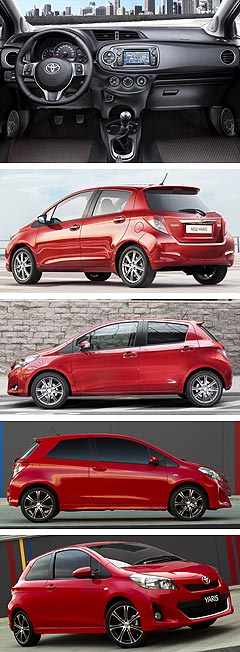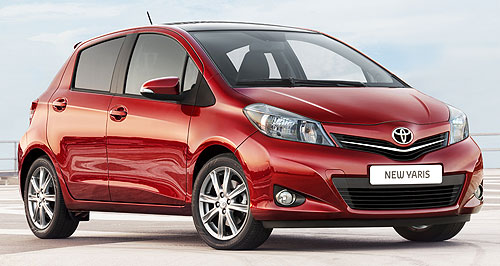Make / Model Search
Future models - Toyota - YarisEurope set, Oz waits for all-new YarisMade in Europe: The UK will get Toyota’s redesigned light car before Australia because it is sourced from a French factory rather than the quake-ravaged Nagakusa production facility in Japan. Aussie launch timing still unclear as Toyota reveals full details of new Euro Yaris14 Jul 2011 TOYOTA in the UK has announced pricing, specifications and engine line-up for the larger, more powerful but lighter and more economical third-generation Yaris light car months ahead of the model’s delayed Australian launch. First deliveries of the redesigned three- and five-door Yaris range will reach UK customers in September – as was planned for the Australian market until it became clear that earthquake and tsunami-related troubles would cause delays at Toyota’s Nagakusa factory in Japan. Toyota Australia public relations manager Mike Breen told GoAuto the company is expecting the Yaris to arrive here in the fourth quarter – about a year after its Japanese launch. “We don’t want to put a stick in the ground or we might build up expectations that we can’t deliver on,” he said. Mr Breen hopes to have a better picture of the first shipment date “within the next week or so” but said Toyota does not yet have 100 per cent confidence of the exact timing. Because the European Yaris is manufactured at Toyota’s Valenciennes factory in France, it is not subject to the same delays. UK pricing pitches the new Yaris – which has been criticised in the British market for being highly priced – from £11,170 ($A16,727), a £440 ($A659) increase for the base model, equivalent to $1737 more expensive than the entry price currently asked of Australians.  Mr Breen said it is still too early to comment on Australian pricing. “Price negotiations tend to go on until a week before we do the launch,” he said. “We’re always seeking a better price.” Bigger but 30kg lighter and more aerodynamic with revised engines and a new ‘Multidrive S’ continuously variable transmission (CVT) – with paddle-shift manual override providing seven simulated gear ratios – the new Yaris promises to offer fuel and CO2 savings over its predecessor. Mr Breen said it is still too early to comment on Australian pricing. “Price negotiations tend to go on until a week before we do the launch,” he said. “We’re always seeking a better price.” Bigger but 30kg lighter and more aerodynamic with revised engines and a new ‘Multidrive S’ continuously variable transmission (CVT) – with paddle-shift manual override providing seven simulated gear ratios – the new Yaris promises to offer fuel and CO2 savings over its predecessor.The Australian engine and specification line-up has not yet been confirmed but Mr Breen confirmed that the 1.5-litre engine will live on and that there will be “some” engine upgrades. Japanese specification sheets show the 1.5-litre engine to be available with the new CVT automatic – which is bound to provide fuel economy and emissions benefits over the outgoing equivalent’s 6.7 litres per 100 kilometres and 160 grams of CO2 per kilometre – but do not provide details of whether there are any changes to the current engine’s 80kW/141Nm outputs. Almost a certainty for Australia is the revised 1.3-litre petrol engine, which gets dual variable valve control to lift peak power and torque outputs to 72kW and 125Nm respectively, an increase of 9kW and 4Nm over the outgoing model. Toyota claims the 1.3 petrol returns fuel economy of 5.0L/100km and produces 118g/km of CO2 when mated to the CVT automatic. Some markets save even more fuel with the fitment of an idle-stop system but this variant is not destined Down Under. If Toyota’s guideline fuel and CO2 figures are borne out under Australian Design Rule (ADR) testing, that is a significant 23 per cent drop over the outgoing 1.3-litre with four-speed automatic, which consumes 6.5L/100km and emits 154g/km of CO2. The UK and other markets continue to get a 1.0-litre three-cylinder petrol engine with a five-speed manual transmission. Toyota claims the 50kW/93Nm unit now uses four per cent less fuel, down to 4.8L/100km, while CO2 output drops seven per cent to 111g/km. Also off the agenda for Australia is the 65kW/205Nm 1.4-litre diesel, with Prius-like fuel consumption of 3.9L/100km (down a claimed seven per cent) and CO2 emissions reduced six per cent to 104g/km. On all but the UK base model, the spartan and simple-looking Yaris dash incorporates a touch-screen audio system featuring Bluetooth and USB connectivity, plus a rearview camera. The system can be upgraded to feature satellite-navigation and internet-connected telematics functions that enable “information services that can be accessed and downloaded via a dedicated Toyota customer portal”. British buyers will be offered four specification levels from the T2 base model through mid-range TR and sporty SR variants to the range-topping T Spirit. The TR comprises 15-inch alloy wheels, air-conditioning, stability control (which will be mandatory across the range in Australia) and the aforementioned touch-screen entertainment system. SR variants get part-leather upholstery plus a sportier exterior, riding on lowered suspension with 16-inch alloys, roof spoiler, tinted windows and front foglights. Top-spec T Spirit variants are five-door only and gain a panoramic glass sunroof, dual-zone climate-control, automatic headlights and wipers, auto-dimming rearview mirror and keyless entry/start. As GoAuto has reported, at 3885mm the new Yaris is a full 135mm longer than its predecessor and the 50mm-longer wheelbase provides 35mm extra rear legroom. Adding to the edgier look and sportier stance is a 20mm lower overall height to complement the extra length, while the width remains the same at 1695mm. The new styling and lower height contribute to a reduced aerodynamic drag coefficient of 0.285Cd (down from 0.30Cd). Dogged by stock shortages following the Japanese earthquake and tsunami, Yaris sales have slipped 29.7 per cent in Australia this year. Having sold 7788 units year-to-date, the Yaris has been demoted to Australia’s third best-selling light car after the Hyundai Getz (in first place) and Mazda2. The Mazda2 outsold the Yaris by almost 1000 units and the Getz – which has been in runout since production ceased in December – achieved 10,057 sales for a 15 per cent segment share. In comparison, the Getz outsold the Yaris by just 95 units in 2010. Stocks of the Getz are likely to have depleted by the time the new Yaris comes to market and Toyota’s production will have had time to recover from the earthquake, leaving the door wide open for the all-new model to reclaim light car supremacy in Australia for the first time since it was usurped by the Getz in 2009. Competition is stronger nowadays but in the early years of the outgoing Yaris model, it enjoyed a near-25 per cent segment share, achieving almost 30,000 annual sales.  Read moreAll future models Alfa Romeo Alfa Romeo Abarth Abarth Alpine Alpine Alpina Alpina Audi Audi Aston Martin Aston Martin BMW BMW Bentley Bentley Chery Chery Brabham Brabham Chrysler Chrysler Chevrolet Chevrolet Cupra Cupra Citroen Citroen DS DS Dodge Dodge Fiat Fiat Ferrari Ferrari Foton Foton Ford Ford Great Wall Great Wall FPV FPV Haval Haval GWM GWM Honda Honda Holden Holden Hummer Hummer HSV HSV Infiniti Infiniti Hyundai Hyundai Jaguar Jaguar Isuzu Isuzu Kia Kia Jeep Jeep Land Rover Land Rover Lamborghini Lamborghini Lexus Lexus LDV LDV Mahindra Mahindra Lotus Lotus Mazda Mazda Maserati Maserati Mercedes-AMG Mercedes-AMG McLaren McLaren MG MG Mercedes-Benz Mercedes-Benz Mitsubishi Mitsubishi Mini Mini Opel Opel Nissan Nissan Peugeot Peugeot Pagani Pagani Proton Proton Porsche Porsche Renault Renault Ram Ram Rover Rover Rolls-Royce Rolls-Royce Skoda Skoda Saab Saab SsangYong SsangYong Smart Smart Suzuki Suzuki Subaru Subaru Toyota Toyota Tesla Tesla Volvo VolvoYaris pricingMotor industry news |
Click to shareToyota modelsResearch Toyota All future models Alfa Romeo Alfa Romeo Abarth Abarth Alpine Alpine Alpina Alpina Audi Audi Aston Martin Aston Martin BMW BMW Bentley Bentley Chery Chery Brabham Brabham Chrysler Chrysler Chevrolet Chevrolet Cupra Cupra Citroen Citroen DS DS Dodge Dodge Fiat Fiat Ferrari Ferrari Foton Foton Ford Ford Great Wall Great Wall FPV FPV Haval Haval GWM GWM Honda Honda Holden Holden Hummer Hummer HSV HSV Infiniti Infiniti Hyundai Hyundai Jaguar Jaguar Isuzu Isuzu Kia Kia Jeep Jeep Land Rover Land Rover Lamborghini Lamborghini Lexus Lexus LDV LDV Mahindra Mahindra Lotus Lotus Mazda Mazda Maserati Maserati Mercedes-AMG Mercedes-AMG McLaren McLaren MG MG Mercedes-Benz Mercedes-Benz Mitsubishi Mitsubishi Mini Mini Opel Opel Nissan Nissan Peugeot Peugeot Pagani Pagani Proton Proton Porsche Porsche Renault Renault Ram Ram Rover Rover Rolls-Royce Rolls-Royce Skoda Skoda Saab Saab SsangYong SsangYong Smart Smart Suzuki Suzuki Subaru Subaru Toyota Toyota Tesla Tesla Volvo VolvoYaris pricingMotor industry news |











Facebook Twitter Instagram